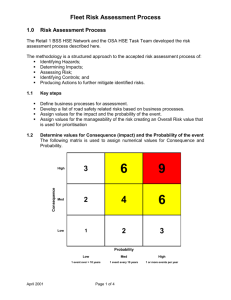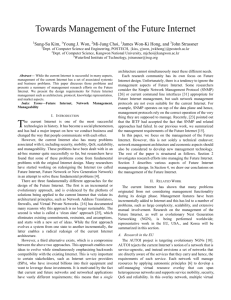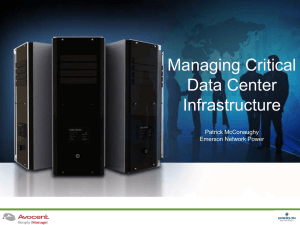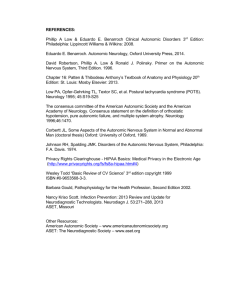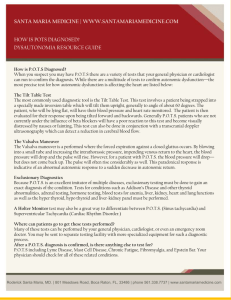Manageability of Future Internet
advertisement
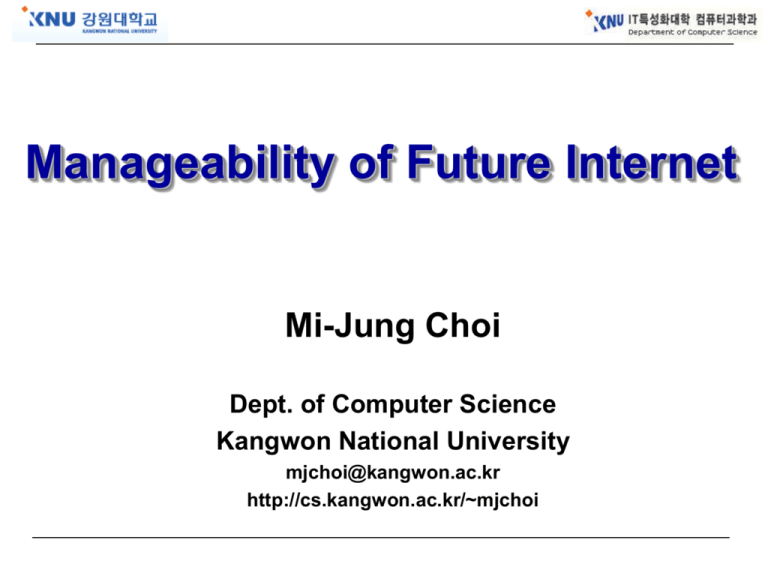
Manageability of Future Internet Mi-Jung Choi Dept. of Computer Science Kangwon National University mjchoi@kangwon.ac.kr http://cs.kangwon.ac.kr/~mjchoi Contents 1. Problems of Current Internet 2. Future Internet Motivation of Future Internet Requirements of Future Internet Research roadmap of Future Internet 3. Management of the Future Internet Management issues of Future Internet Research efforts for management of Future Internet 4. Summary (2) Manageability of Future Internet Manageability of Future Internet Technical Problems of the Internet (1/2) Fundamental design principles of the current Internet Collaboration Trust Use of intelligence at the edges to enable the core to be simple Hard to map the current demands of users to services and resources that the network can offer (different domains) Lack of security Lack of mobility support Interaction problems between the different layers (4) Manageability of Future Internet Technical Problems of the Internet (2/2) No guarantee on QoS – best effort service Very difficult to manage due to explosive growth in # of devices & network traffic amount There is no single standard for representing information that can be shared among heterogeneous applications and information sources (5) Manageability of Future Internet Business Problems of the Internet Each vendor uses different programming languages and models Difficult to integrate data from devices from multiple vendors It is becoming increasingly hard to make a profit Unless the future network architecture takes competition and economic incentive, it is doomed to failure New architecture has to be based on a sound economic model, not just a good technical one (6) Manageability of Future Internet Manageability of Future Internet Motivation for Future Internet Need to resolve the challenges facing today’s Internet by rethinking the fundamental assumptions and design decisions underlying its current architecture Three approaches 1. Incremental (non-evolutionary): a system is move from one state to another with incremental patches; new ideas that are not compatible with the original design are not allowed 2. Incremental (evolutionary): same as above, except new ideas that are not compatible with the original design are allowed 3. Clean-slate (revolutionary): redesigned from scratch to offer improved abstractions and/or performance, while providing similar functionality based on new core principles (8) Manageability of Future Internet What is Future Internet? Next Generation Network (NGN)? a packet-based network to support the transfer of mixed traffic types such as voice, video, and data and to integrate services offered by traditional networks and new innovative IP into a single platform Internet designed in accordance with either of the two incremental approaches Future Internet? Clean Slate design of the Internet’s architecture to satisfy the growing demands Management issues of Future Internet also need to be considered from the stage of design Research Goal for Future Internet Performing research for Future Internet and designing new network architectures Building an experimental facility (9) Manageability of Future Internet Research Roadmaps for Future Internet NSF NeTS-FIND Architecture Project US 2006 (Future Internet) Network testbed 2002 PlanetLab NSF GENI GENI 2008-2009 FP7 FP6 EU NGI (Future Network/ Future Internet) FIRE Euro-NGI(€5M) 2002 Euro-FGI 2006 2007 2008 JP 2007 2013 4WARD NWGN Promoting Forum Network testbed (NeW Generation Network) 2004 JGN II JGN2Plus Architecture Project 2006 AKARI project 2006 KR (Future Internet) 2002 FIF KOREN2 KOREN 2008 2000 JGN X CASFI Now 2005 (10) 2010 2015 Manageability of Future Internet Requirements for Future Internet Security • Seamless handoff/roaming • Identity/addressing Mobility • Guarantee of service quality • Key part of SLA • Integrity, authenticity, confidentiality of communication with any given peer • Virtualization of Resources Scalability Interoperability Reliability Availability Virtualization • FCAPS • Autonomic Management Manageability QoS (11) Manageability of Future Internet Requirements for Future Internet Security • Seamless handoff/roaming • Identity/addressing Mobility • Integrity, authenticity, confidentiality of communication with any given peer • Virtualization of Resources Scalability Interoperability Reliability Availability Virtualization Manageability • Intelligent and programmable network nodes • FCAPS • Autonomic Management Manageability Programmability (12) Manageability of Future Internet Manageability of Future Internet THINK about Manageability of Future Internet We need not only evolutionary approach But also revolutionary approach FCAPS (14) ? Manageability of Future Internet Management Issues for FI (1/3) Management Interface Management Information Modeling & Operations Complexity of management should be confined The management plane should be independent of the data plane Management Architecture Centralized vs. Decentralized Management Peer-to-Peer Hybrid Service Management Customer-centric service Service portability SLA/QoS (15) Manageability of Future Internet Management Issues for FI (2/3) Traffic Monitoring/Measurement and Analysis Monitoring for large-scale and high-speed networks Network/application-level monitoring Global traffic data access/sharing Fast and real time monitoring Statistical sampling method Storing method for large scale traffic data Measurement and analysis of social networking (16) Manageability of Future Internet Management Issues for FI (3/3) Autonomic Management/Self-Management Knowledge Engineering, including Information Modeling and Ontology Design Policy Analysis and Modeling Semantic Analysis and Reasoning Technologies Reduction of manual errors and faster configuration Management with fewer human resources Self-Managed Networks Orchestration Techniques Context and Context-awareness Adaptive management (17) Manageability of Future Internet Research Efforts for Management of FI US NSF Future Internet Design (FIND) Complexity Oblivious Network Management architecture (CONMan) Global Environment for Networking Innovations (GENI) Operations, Management, Integration and Security (OMIS) WG EU FP 7 4WARD In-network (INM) project Autonomic Internet (AutoI) project Autonomic Network Architecture (ANA) project Korea Capture, Analyze, Share for Future Internet (CASFI) (18) Manageability of Future Internet CONMan Architecture (1/2) Management interface should contain as little protocol-specific information as possible Complexities of protocols should be masked from management Goal A generic abstraction of network entities (protocols & devices) for management purpose A set of atomic management operations to work upon the abstraction A way to translate high-level management objectives to low-level operations (19) Manageability of Future Internet CONMan: Shift Complexities (2/2) Management interface should contain as little protocol-specific information as possible Complexities of protocols should be masked from management Solution The management interface of data-plane protocols should contain as little protocol-specific information as possible Allows data-plane protocols to have a generic yet simple interface (20) Manageability of Future Internet GENI OMIS WG (1/2) GENI OMIS WG (Operations, Management, Integration and Security) Operations, management, integration and security processes in GENI Experiment support, monitoring, and data storage Security monitoring and incident response Federation management and monitoring Hardware release, maintenance and integration Software release, maintenance and integration Operations metric collection and analysis http://www.geni.net/wg/omis-wg.html (21) Manageability of Future Internet GENI OMIS WG (2/2) Federation of substrates questions Dependencies across substrates Is the control plane centralized? How to separate the experiment from the operation OMIS data is separate from the GENI data Substrate needs from OMIS Fault tolerance Security requirements (22) Manageability of Future Internet 4WARD (1/3) 4WARD Divided into 6 work package (WP) In Network Management (INM) Autonomic self-management Abstractions and a framework for a self-organizing management plane Scheme, strategies, and protocols for collaborative monitoring, selfoptimizing, and self-healing (23) Manageability of Future Internet 4WARD (2/3) Traditional network management In-network Management A new management paradigm Management functions come as embedded capabilities of the devices Pushing management intelligence into the network (24) Manageability of Future Internet 4WARD (3/3) Three dimensional functional space Degree of embedding Degree of autonomicity Degree of abstraction moving from a managed object paradigm to one of management by objective (25) Manageability of Future Internet AutoI (1/3) Main objective of AutoI Provision of a self-managing virtual resource overlay Autonomic Internet vision at a high level AutoI is an optimized network and service layers solution which guarantees built‐in orchestrated security, reliability, robustness, mobility, context, access, service support and self management of the communication resources and services A transition from a service agnostic Internet to service-aware network by applying Autonomic principles to the management of network resources (26) Manageability of Future Internet AutoI (2/3) Autonomic Internet approach (27) Manageability of Future Internet AutoI (3/3) Inside (In) Network functions Management functionality should be embedded in the network Aware and Self-aware functions Monitor network and operational context to assess if the network serve its service purposes Adaptive and self-adaptive functions Triggers changes in network operations function of the changes in network context Autonomic self-functions Self-control (i.e. self-FCAPS ) Extensibility functions Add new functions without disturbing the rest of the system Simple functions Minimize life-cycle network operations (28) Manageability of Future Internet ANA (1/4) Goal Build a network architecture for future internetworking (including autonomic features) Key ideas with regard to experimentation Two development cycles Early prototype + redesign after first implementation The need for experimentation An architecture can not be built An architecture has to grow (29) Manageability of Future Internet ANA (2/4) WP1: Architecture WP2: Autonomic Communication System WP4: Integration, applications, Testbed WP3: WP0: Self-management, Project Management Resilience, security (30) Manageability of Future Internet ANA (2/4) WP1: Architecture WP2: Autonomic Communication System WP3: WP4: Integration, applications, Testbed Self-management, WP0: WP3: Resilience, security Self-management, Project Management Resilience, security (31) Manageability of Future Internet ANA (3/4) ANA monitoring architecture Self optimization mechanisms Implementation of selected components of the failure detection and fault management Measurement-based resilience mechanisms (32) Manageability of Future Internet ANA (4/4) Monitoring Architecture Basic idea Decompose monitoring functionality into multiple individual functional blocks Building a foundation on which autonomic applications can be build (33) Manageability of Future Internet CASFI CASFI (Collect, Analyze, and Share for Future Internet) Goals Manageability of Future Internet Data Sharing Platform for Performance Measurement High-Precision Measurement and Analysis Human Behavior Analysis Groups KAIST, POSTECH, Chungnam National University, KyungHee University Period 2008.03.01 ~ 2013.02.28 http://casfi.kaist.ac.kr (34) Manageability of Future Internet Manageability of Future Internet Summary Future Internet Future Internet needs to overcome the problems of the current Internet (security, mobility, scalability, etc.) We need to include the manageability the initial design of the Future Internet Research efforts for management of FI ANA, CONMan, INM: Goal is clear. Prototype and implementation work is going on GENI OMIS, AutoI: Still high level.. (36) Manageability of Future Internet (37) Manageability of Future Internet


